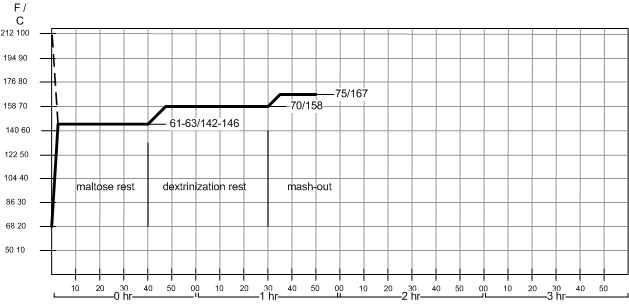
theory behind step mashing?
#1

Posted 27 January 2012 - 06:19 AM
#2

Posted 27 January 2012 - 08:22 AM
#4

Posted 27 January 2012 - 10:12 AM
#5

Posted 27 January 2012 - 10:14 AM
#6

Posted 27 January 2012 - 10:15 AM
yeah - not really thick but slightly thicker than what I normally do these days.1.25 qt/lb is thick? I do it with pretty much every brew because of space restrictions in my MT. I am not sure if it qualifies directly, I made it up to suit my needs. For example, I will mash in at 148, let it rest half an hour. Pull off 2 gal of liqour and bring that to a boil, add it back. This will raise it somewhere in the mid 150s. Rest 10 minutes, pull off another 2 gal, boil, repeat. It takes another time or two to get it to 172. Once there, vorlauf, run off, sparge. I don't really fly sparge, but I don't batch sparge either. I just keep the bed floating and add in a few qts of sparge water at a time while I run off.
#7

Posted 27 January 2012 - 10:22 AM
so in the case of my vienna lager - what was your thought process behind suggesting 148F for 45 min followed by 160F? was it to keep the beer from getting too thin and dry? did you mean to say I should do a protein rest first?It improves the overall body and mouthfeel, it also aids in head retention.
#8

Posted 27 January 2012 - 10:23 AM
#9

Posted 27 January 2012 - 10:34 AM
The Vienna and Munich malts will add a nice maltiness, this technique allows you to dry it out without it tasting to dry. I think it helps show off the maltiness in this type of beer.so in the case of my vienna lager - what was your thought process behind suggesting 148F for 45 min followed by 160F? was it to keep the beer from getting too thin and dry? did you mean to say I should do a protein rest first?
#10

Posted 27 January 2012 - 10:57 AM
what's happening that allows this to happen? for instance - if I just did the infusion at 148F for 60 min and then mashed it out, how would this differ from 45 min then essentially a mash out?The Vienna and Munich malts will add a nice maltiness, this technique allows you to dry it out without it tasting to dry. I think it helps show off the maltiness in this type of beer.
#11

Posted 27 January 2012 - 11:02 AM
In the link I posted read the Hochkurz mash, it is all in there.what's happening that allows this to happen? for instance - if I just did the infusion at 148F for 60 min and then mashed it out, how would this differ from 45 min then essentially a mash out?
#12

Posted 27 January 2012 - 11:09 AM
hey - there are three steps there!!! ;)I don't think I'll have the water to hit that mash out (167F) - is this a problem if I just leave it overnight at 160ish F?In the link I posted read the Hochkurz mash, it is all in there.
#13

Posted 27 January 2012 - 11:10 AM
Not a problem, that is what I did on my pilsner.ETA: I just try to hit mashout on my second runnings, so not really a third step.hey - there are three steps there!!! ;)I don't think I'll have the water to hit that mash out (167F) - is this a problem if I just leave it overnight at 160ish F?
#14

Posted 27 January 2012 - 11:14 AM
that's what I typically do as well but now that I tend to overnight mash there is a big span of time between the 2nd and third steps that wasn't there before. I guess now that I think about it I've been pretty much doing a Hochkurz mash all along except fairly often my second step isn't nearly high enough in temperature b/c I don't unbalance my runnings slightly to get there.edit: also my first step lasts too longNot a problem, that is what I did on my pilsner.ETA: I just try to hit mashout on my second runnings, so not really a third step.
#15

Posted 27 January 2012 - 11:17 AM
#16

Posted 27 January 2012 - 11:21 AM
If this seems to go smoothly maybe this will be my new mashing technique for all things german.
is there a benefit to doing a similar mash for other beers where the initial rest is at a higher temperature?
edit: graph of mash in question...

#17

Posted 27 January 2012 - 11:24 AM
#18

Posted 27 January 2012 - 11:25 AM
I do a regular mash on hoppy beers as I am trying to showcase the hops.
If this seems to go smoothly maybe this will be my new mashing technique for all things german.
is there a benefit to doing a similar mash for other beers where the initial rest is at a higher temperature?
edit: graph of mash in question...
#19

Posted 27 January 2012 - 07:22 PM
I'm not sure I could say that. I continue top gho back and forth between step mashing and single infusion to see if I can find an advantage to step mashing. So far I don't think I have.It improves the overall body and mouthfeel, it also aids in head retention.
#20

Posted 27 January 2012 - 07:22 PM
1 user(s) are reading this topic
0 members, 1 guests, 0 anonymous users









